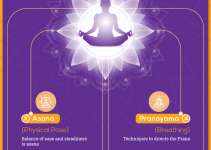- What it’s
- Brahmacharya & spirituality
- Brahmacharya in Yoga
- Absolute Vs Relative Brahmacharya
- Benefits
- How to Practice?

The word Brahmacharya is derived from two Sanskrit words: Brahman, meaning the Divine or Absolute Consciousness, and Charya, meaning conduct. Thus, Brahmacharya literally translates to “conduct that leads to the realization of Absolute Consciousness.”
Practically, Brahmacharya is often synonymous with celibacy, referring to a voluntary vow of sexual abstinence.
However, sexual abstinence and living in solitude do not fully define Brahmacharya. It can also be practiced while living in the world, interacting with people, and leading a normal, active life. More than abstinence, Brahmacharya is about cultivating an attitude of living above all temptations. Swami Vivekananda, Sri Ramakrishna, and Paramahansa Yogananda are notable examples of individuals who embodied this principle.
What exactly is brahmacharya?
Brahmacharya is the path that leads to the awareness of divine existence. This divine existence has been described in various ways, such as universal consciousness, the source of creation, cosmic life force, superintelligence, and God. However, to humanity’s best understanding, these all point to the same ultimate reality.
According to the Darshana Upanishad, the constant focus of the mind on the path of becoming one with Brahman is called Brahmacharya.
In yoga, the practice of Brahmacharya comes under the Yama, the first of eight limbs. The Yama consists of 5 yogic disciplines that are considered self-restraint practices for a yogi. From this point of view, Brahmacharya is the practise of restraining the temptation of sexual desire and freedom from lust in thought, word and deed.
Is brahmacharya a spiritual practice?

Swami Sivananda Saraswati says, “A man has a thousand and one desires, but the central, strongest desire is sexual desire.” This desire is so powerful that, on a physical level, it can create new life. Therefore, in the practice of Brahmacharya, this powerful sexual energy is channeled to bring about a “new life” in a spiritual and energetic sense.
So how does Brahmacharya lead to self-realization? Let’s take a step back and understand inner joy. Pursuing inner joy is at the heart of all religious practices. Inner joy is nothing but the absence of negative emotions. And true inner joy initiates when our mind is liberated from emotional and intellectual entanglements.
This liberated mind is the fundamental prerequisite on the path to self-realization. The cognition of a liberated mind is solely focused on projecting its consciousness into the universal consciousness. It creates a sense of oneness with the whole creation, also known as divine awareness.
This begs the question: what is individual consciousness and what is universal consciousness? You can think of individual consciousness as a super sense formed by the harmonious synchronisation of all five senses that generates your perception of complete awareness.
Now universal consciousness is tricky because it lacks a scientific establishment. All popular theories are just self-realizations at some point. Still, for the sake of understanding, think of it as an extensive network of consciousness that connects all individual consciousnesses across the universe.
Now as a liberated mind projects its consciousness into the universal consciousness, it generates an experience of oneness with the whole creation; an experience considered of highest reverence in spiritual terms or an experience synonymous with the awareness of the divine.
Brahmacharya & sexual abstinence
Now that we have established what is awareness of divinity, let’s explore how Brahmacharya leads to it. Brahmacharya suggests Abstinence of sexual expressions and interactions. This is because sexual experiences can be very overpowering to your senses. Your senses stay busy interpreting sexual messages while neglecting the pursuit of complete awareness.
Sexual experiences can often generate toxic emotion and intellect, that too, mislead your cognition from the path of self-realization. Additionally, the emotional intensity of sexual interactions can disturb different biochemical processes in the body, generating physical harm as well.
Hence, sexual interactions are seen as liabilities to your mind and body, that generate further worldly entanglements, rather than liberation. The practice of Brahmacharya creates mind and body conditions that are favourable to the liberation of the mind.
Brahmacharya in yoga (as 4th yama)

The order followed in setting the Yamas are very systematic and interconnected; one leads to the next. The first Yama ahimsa, or non-harming, forms the framework for the Yama moral code. The core purpose of Raja yoga, which is, gaining mastery of mind and body to serve the well-being of others, is built on the philosophy of non-harming. Thus every limb of ashtanga yoga and every other moral value in Yama draws, essentially, from the essence of ahimsa.
Consequently, Brahmacharya too has a strong connection with ahimsa. One might even say that Brahmacharya is an extension of ahimsa. Thus in practice, Brahmacharya (as a Yama) prohibits a sexual expression depending on whether it is harmful or not. Brahmacharya maintains a similar relationship with the Yamas Satya and Asteya.
A sexual expression can cause harm (himsa) for reasons like its lying nature (extra-marital) or stealing nature (stealing of time, privacy, dignity, integrity and emotion.) Thus Brahmacharya corresponds with Satya and Asteya, by prohibiting sexual expressions that are of lying and stealing nature.
To evaluate the “one leads to another” concept of Yama, it can be assumed that one who is well adjusted to the 1st, 2nd and 3rd Yamas will naturally incorporate some aspects of Brahmacharya. For example, a person deeply rooted in ahimsa, Satya and Asteya, will never be entangled in a sexual interaction that causes any kind of harm to another.
Absolute Vs Relative brahmacharya
To completely block an activity as basic as procreation might seem a little totalitarian to some. But the yogic tradition is more progressive than people give it credit for. The theory of Brahmacharya is divided into two types, absolute and relative Brahmacharya.
Absolute Brahmacharya refers to complete abstinence of sexual activities, interactions, expressions and thoughts. This type of Brahmacharya is practised by yogis living in isolation from society, mostly seeking spiritual pursuits.
Relative Brahmacharya is for the ones who seek spiritualism while living within the society. Such people will have families and relationships. Procreation and sexual expressions will be their social responsibility. Thus complete abstinence is not a possibility. When these people pursue spiritualism, they will need to practice a relative version of Brahmacharya. The relative version suggests sexual expression with moderation.
This is a common misconception that there is a natural “sexual instinct” in human beings. It is not so. The natural instinct is the procreative one. If men and women restrict sexual indulgence to mere procreation, then that itself is the observance of relative Brahmacharya.
In practice, relative Brahmacharya would have the practitioner engage in sexual interactions only with his/her spouse. The practice also recommends limiting sexual thoughts for purpose of procreation only. This exclusivity will generate a state of emotional well-being and avoid harm to self and others.
Brahmacharya in modern context
In a contemporary world, the idea of sexual abstinence has made Brahmacharya quite unpopular. Especially with different spiritual practices like shamanism and Tantra, which worships sexual practices.
To be honest this lack of love for Brahmacharya is quite unfounded and owed to the serious lack of understanding. The core reason of Brahmacharya is to avoid emotional and physical harm to self and others, that are associated with sexual entanglements. This core idea is what you should bear in mind when approaching Brahmacharya.
In fact, the practices like Tantra that revere the sexual rituals have similar beliefs at the centre. Sexual practices are encouraged as they can greatly regulate the energy flow, and help in awakening the inner Shakti. Sexual interactions in such practices are used as an instrument of meditation and reject all pleasure and emotional entanglements. So even for spiritual disciplines that worship sexual intercourse, strictly prohibits entanglements.
In a contemporary world, one need not choose absolute sexual abstinence; a moderated version should suffice. And when relative Brahmacharya is practised, sexual intercourse with your spouse could become spiritually enriched and lead to self-realization. What is important is that your sexual expression in excess is not becoming an obstacle or cause of harm to yourself or another.
Benefits of Brahmacharya
Brahmacharya can have many benefits, both physically and mentally; which leads to spiritual development. Physically, it can directly impact your sexual hormones. A lifestyle involving mindless sexual engagements can lead to depleting levels of sexual hormones. This can lead to stress, poor metabolism and deteriorating organ growth and muscle health.
The practice of Brahmacharya will maintain your hormonal levels in general, and sexual hormone levels in particular. It will further uplift your overall mental and physical health. Further, the practice of Brahmacharya avoids emotional and intellectual entanglements that keep you psychologically stable. The prominent benefits of Brahmacharya are as follows:
- Healthy hormonal functions
- Strong immunity and metabolism
- Improved musculoskeletal growth and maintenance
- Clarity of thought
- A guilt free conscience
- Improved self confidence and self worth
- Reduced levels of stress and anxiety
How to practice Brahmacharya?
Practising brahmacharya depends on a mixture of things. It starts with developing an innate sense of ahimsa. It will be followed by developing a strong understanding of the connection between sexual intercourse and your mind and body.
You will then have to condition your mind and body to supplement the process of Brahmacharya. Next, you will need to make lifestyle moderations and dietary changes that will help you sustain the path of Brahmacharya. And last but not the least, meditate.
The following are a few practices for Brahmacharya one could consider:
- Words can nurture even the most barren mind. Thus reading helps gather perspective. Read philosophical books like the ones by Mahatma Gandhi and Swami Vivekananda, to understand the philosophy of ahimsa and Brahmacharya.
- Read biological and anatomical books to understand how sexual activities impact your mind and body.
- Sexual abstinence will bring about a lot of biochemical changes that can be overwhelming in the beginning. Thus to normalize, engage in Pranayama.
- Practice certain Asana that naturally accompany the path of Brahmacharya -Brahmacharyasana, Dandasana, Vajrasana, Balasana, Bhujangasana, Vrikshasana, Surya Namaskar and Chakravakasana.
- Try to explore spirituality through sexual intercourses with your spouse. Over time you will start associating sexual experiences with a sublime transformational process, and not some mindless pleasure entanglement object.
- Be watchful of your diet, and don’t eat more than you need. Avoid excessive consumption of animal fat and red meat.
Brahmacharya is essential going against one of our primal inclinations, it is going against our biology. Thus the practice will not be easy and will test the maximum limits of your moral fibre. So obviously patience and meditation will be key to your practice. Do not expect any changes overnight, rather an extensive pursuit spread across a span of years. And there will be times when you will feel frustrated, emotionally and sexually, quickly retreat to pranayama or meditation to tackle such spurts of frustration.




